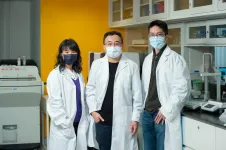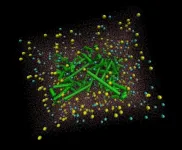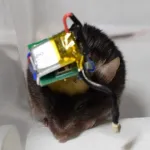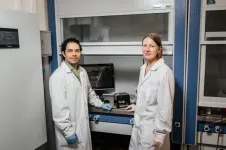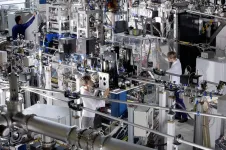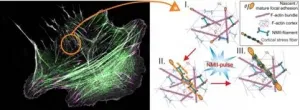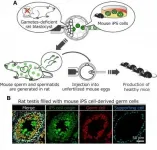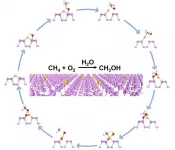Plastic solar cells combine high-speed optical communication with indoor energy harvesting
2021-03-02
(Press-News.org) Around the world there are currently more than 18 billion internet-connected mobile devices. In the next 10 years, anticipated growth in the Internet of Things (IoT) and in machine-type communication in general, will lead to a world of hundreds of billions of data-connected objects. Such growth poses two very challenging problems:
How can we securely connect so many wireless devices to the Internet when the radio-frequency bandwidth has already become very scarce?
How can all these devices be powered?
Regular, manual charging of all mobile Internet-connected devices will not be feasible, and connection to the power-grid cannot be generally assumed. Therefore, many of these mobile devices will need to be able to harvest energy to become largely energy-autonomous.
In a new paper published in Light Science & Application, researchers from the University of Strathclyde and the University of St Andrews have demonstrated a plastic solar panel that combines indoor optical energy harvesting with simultaneously receiving multiple high-speed data signals by multiple-input multiple-output (MIMO) visible light communications (VLC).
The research, led by Professor Harald Haas from the Strathclyde LiFi Research and Development Centre, and Professors Ifor Samuel and Graham Turnbull at the St Andrews Organic Semiconductor Centre, makes an important step towards the future realization of self-powered data-connected devices.
The research teams showed that organic photovoltaics (OPVs), solar cells made from similar plastic-like materials to those used in OLED smartphone displays, are suitable for high-speed optical data receivers that can also harvest power. Using an optimized combination of organic semiconductor materials, stable OPVs were designed and fabricated for efficient power conversion of indoor lighting. A panel of 4 OPV cells was then used in an optical wireless communication experiment, receiving a data rate of 363 Mb/s from an array of 4 laser diodes (each laser transmitting a separate signal), while simultaneously harvesting 11 mW of optical power.
Prof Turnbull explained:
"Organic photovoltaics offers an excellent platform for indoor power harvesting for mobile devices. Their advantage over silicon is that the materials can be designed to achieve maximum quantum efficiency for typical LED lighting wavelengths. Combined with the data reception capability, this opens up a significant opportunity for self-powered Internet of Things devices."
Prof Haas added:
"Organic photovoltaic cells are very attractive because they are easily made and can be flexible, allowing mass integration into internet-connected devices. In addition, compared to inorganic detectors, OPVs have the potential to be significantly cheaper, which is a key driver to their large-scale commercial adoption.
Visible light communication provides unregulated, safe and vast resources to alleviate emerging wireless capacity bottlenecks. Of course, visible light can also provide energy. To achieve both objectives with a single device, new solar cells are needed. They must be capable of simultaneously harvesting energy and detecting data at high speeds. It is, therefore, essential to develop solar cells that have two key features: a) they exhibit a very large electrical bandwidth in the photovoltaic mode of operation, and b) have a large collection area to be able to collect a sufficient number of photons to achieve high signal-to-noise ratio (SNR) and harvest maximum energy from light. Regrettably, the two requirements are typically mutually exclusive because a large detector area results in a high capacitance and hence low electrical bandwidth.
In this research, we have overcome this fundamental limitation by using an array of OPV cells as a MIMO receiver to establish multiple parallel and independent data channels while being able to accumulate the harvested energies of all individual solar cells. To the best of our knowledge, this has never been shown before. This work therefore lays the foundation for the creation of a very large, massive MIMO solar cell receiver enabling hundreds and potentially thousands of individual data streams while using the huge collection area to harvest large amounts of energy from light (both data carrying and ambient light). It is imaginable to turn entire walls into a gigabit per second data detector while harvesting sufficient energy to power many distributed intelligent sensors, data processing and communication nodes."
INFORMATION:
[Attachments] See images for this press release:
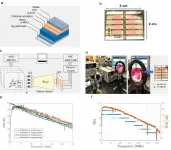
ELSE PRESS RELEASES FROM THIS DATE:
2021-03-02
A Hong Kong Baptist University-led (HKBU) research team has developed a novel drug which has the potential to become a next-generation treatment for cancers associated with Epstein-Barr virus (EBV).
The peptide-linked drug, which is responsive to the acidic environment found in tumours, is the first known agent to have successfully targeted two viral proteins that are simultaneously produced by EBV. It also offers a new strategy by increasing the uptake of anti-cancer drugs in tumour cells, thus allowing the application of lower drug dosages which helps reduce treatment side effects and health risks.
The research results were published in the international academic journal Advanced Science.
New drug targets ...
2021-03-02
Modern electronics is approaching the limit of its capabilities, which are determined by the fundamental laws of physics. Therefore, the use of classical materials, for example, silicon, is no longer able to meet the requirements for energy efficiency of the devices. Currently, it is necessary to start searching for new materials, new principles of electronic devices' functioning. To solve this problem, researchers of Peter the Great St.Petersburg Polytechnic University (SPbPU) are developing thin films, the elements for biomolecular electronics. Scientists believe that biological macromolecules such as nucleic acids, proteins, amino acids can become a promising material for modern ...
2021-03-02
Overview:
A research team at the Department of Electrical and Electronic Information Engineering, Department of Computer Science and Engineering, Department of Applied Chemistry and Life Science, and the Electronics-Inspired Interdisciplinary Research Institute (EIIRIS) at Toyohashi University of Technology has developed a lightweight, compact, Bluetooth-low-energy-based wireless neuronal recording system for use in mice. The wireless system weighs END ...
2021-03-02
A number of scientists whose work is inspired by natural behavior is constantly growing. The lotus flower, with its ability to self- clean, is commonly described in literature and can be best examples the trend. Researchers started to wonder why the flower behaves in this manner and they decided to study its structure with the use of microscopes. Hence, they could draw the conclusion that the structure is highly hydrophobic, i.e. it maintains water drops on the surface. Water then collects particles of dust and by flowing down, removes them by flowing down. It means the adhesion forces, those responsible ...
2021-03-02
The lists of Earth's endangered animals and plants are getting increasingly longer. But in order to stop this trend, we require more information. It is often difficult to find out exactly where the individual species can be found and how their populations are developing. According to a new overview study published in Methods in Ecology and Evolution by Dr Annegret Grimm-Seyfarth from the Helmholtz Centre for Environmental Research (UFZ) and her colleagues, specially trained detection dogs can be indispensable in such cases. With the help of these dogs, the species sought can usually be found faster and more effectively than with other methods.
How many otters are there ...
2021-03-02
TPU researchers jointly with their colleagues from foreign universities have developed a method that allows for a laser-driven integration of metals into polymers to form electrically conductive composites. The research findings are presented in Ultra-Robust Flexible Electronics by Laser-Driven Polymer-Nanomaterials Integration article Ultra-Robust Flexible Electronics by Laser-Driven Polymer-Nanomaterials Integration, published in Advanced Functional Materials academic journal (Q1, IF 16,836).
"Currently developing breakthrough technologies such as the Internet of Things, flexible electronics, brain-computer interfaces will have a great impact on ...
2021-03-02
The key are the ultra-fast flashes of light, with which the team led by Dr. Friedrich Roth works at FLASH in Hamburg, the world's first free-electron laser in the X-ray region. "We took advantage of the special properties of this X-ray source and expanded them with time-resolved X-ray photoemission spectroscopy (TR-XPS). This method is based on the external photoelectric effect, for the explanation of which Albert Einstein received the Nobel Prize in Physics in 1921.
"For the first time, we were able to directly analyze the specific charge separation and subsequent processes when light hits a model system such as an organic solar cell. ...
2021-03-02
Research groups at the University of Helsinki uncovered how motor protein myosin, which is responsible for contraction of skeletal muscles, functions also in non-muscle cells to build contractile structures at the inner face of the cell membrane. This is the first time when such 'mini-muscles', also known as stress fibers, have been seen to emerge spontaneously through myosin-driven reorganization of the pre-existing actin filament network in cells. Defects in the assembly of these 'mini-muscles' in cells lead to multiple disorders in humans, and in the most severe cases to cancer progression.
A new study published in eLife, drills into the core mechanisms of stress fiber assembly, and reveals how stress fibers can be built directly ...
2021-03-02
Okazaki, Japan - Making gametes such as sperm and eggs from pluripotent stem cells, primitive cells that can make all the tissues, greatly contributes to efficient reproduction of livestock animals and future assisted reproductive medicine. Researchers pave the way to achieve this goal using a body of xenogenic animals.
The researchers previously developed a method to grow stem cells into an entire organ in the body, so-called blastocyst complementation. The blastocyst is a structure of early embryos. If stem cells are transplanted into the blastocyst obtained from animals that cannot make a certain organ, ...
2021-03-02
Advances in hydraulic fracturing technology have enabled discovery of large reserves of natural gas which primarily contains methane, which is mainly burned directly and causing global warming potentially. Upgrading methane to greener energy such as methanol through aerobic oxidation is an ideal way to solve the problem and remain 100% atom economy.
Yet the difficulties lie in activating methane and preventing methanol from over-oxidation. Methane takes a stable non-polar tetrahedral structure with high dissociation energy of C-H bond, which requires high energy to be activated. ...
LAST 30 PRESS RELEASES:
[Press-News.org] Plastic solar cells combine high-speed optical communication with indoor energy harvesting

